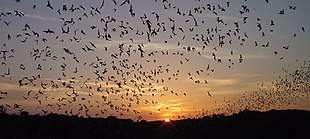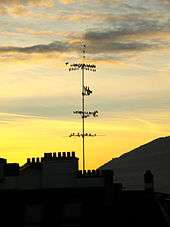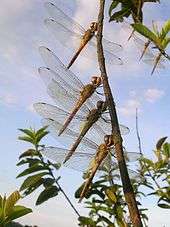Animal migration
Animal migration is the relatively long-distance movement of individual animals, usually on a seasonal basis. It is the most common form of migration in ecology. It is found in all major animal groups, including birds, mammals, fish, reptiles, amphibians, insects, and crustaceans.[1] The trigger for the migration may be local climate, local availability of food, the season of the year or for mating reasons.[2] To be counted as a true migration, and not just a local dispersal or irruption, the movement of the animals should be an annual or seasonal occurrence, such as Northern Hemisphere birds migrating south for the winter; wildebeest migrating annually for seasonal grazing; or a major habitat change as part of their life, such as young Atlantic salmon or sea lamprey leaving the river of their birth when they have reached a few inches in size.[3][4]

Overview
Migration can take very different forms in different species, and as such there is no simple accepted definition of migration. One of the most commonly used definitions, proposed by Kennedy[5] is
Migratory behavior is persistent and straightened out movement effected by the animal’s own locomotory exertions or by its active embarkation upon a vehicle. It depends on some temporary inhibition of station keeping responses but promotes their eventual disinhibition and recurrence.[5]
Migration encompasses four related concepts: persistent straight movement; relocation of an individual on a greater scale (both spatially and temporally) than its normal daily activities; seasonal to-and-fro movement of a population between two areas; and movement leading to the redistribution of individuals within a population.[1] Migration can be either obligate, meaning individuals must migrate, or facultative, meaning individuals can "choose" to migrate or not. Within a migratory species or even within a single population, often not all individuals migrate. Complete migration is when all individuals migrate, partial migration is when some individuals migrate while others do not, and differential migration is when the difference between migratory and non-migratory individuals is based on age or sex (for example).[1]
While most migratory movements occur on an annual cycle, some daily movements are also referred to as migration. Many aquatic animals make a diel vertical migration, travelling a few hundred meters up and down the water column,[6] while some jellyfish make daily horizontal migrations, traveling a few hundred meters across a lake.[7]
Irregular (non-cyclical) migrations such as irruptions can occur under pressure of famine, overpopulation of a locality, or some more obscure influence.[8]
Seasonal migration is the movement of various species from one habitat to another during the year. Resource availability changes depending on seasonal fluctuations, which influence migration patterns. Some species such as Pacific salmon migrate to reproduce; every year they swim upstream to mate and then return to the ocean.[9] Temperature is a driving factor of migration that is dependent on the time of year. Many species, especially birds, migrate to warmer locations during the winter to escape poor environmental conditions.[10]
Circadian migration is where birds utilize circadian rhythm (CR) to regulate migration in both the fall and the spring. In circadian migration clocks of both circadian (daily) and circannual (annual) patterns are utilized to determine the birds’ orientation in both time and space as they migrate from one destination to the next. This type of migration is advantageous in birds that during the winter remain close to the equator, and also allows the monitoring of the auditory and spatial memory of the birds’ brain to remember an optimal site of migration. These birds also have timing mechanisms that provide avians with the distance required to travel in order to reach their destination.[11] To regulate the migration patterns of these birds, the mammalian circadian clock is utilized. This clock allows birds to determine when the appropriate time is to migrate, which location will best help them regulate their metabolism, and whether land or water travel will be most advantageous.[12]
Tidal migration is the use of tides by organisms to move periodically from one habitat to another. This type of migration is often used in order to find food or mates. Tides can carry organisms horizontally and vertically for as little as a few nanometers to even thousands of kilometers.[13] The most common form of tidal migration is to and from Intertidal zone during daily tidal cycles.[13] These zones are often populated by many different species and are nutrient rich. Organisms like crabs, nematodes, small fish, corals, and other species cycle to these areas as the tides rise and fall typically about every twelve hours. The cycle movements are associated with foraging of marine and bird species. Typically, during low tide smaller or younger species will emerge to forage because they can survive in the shallower water and have less chance of being preyed upon. During high tide, larger species can be found due to the deeper water and nutrient upwelling from the tidal movements. Tidal migration is often facilitated by ocean currents.[14]
In specific groups

Different kinds of animal migrate in different ways.
In birds
Approximately 1,800 of the world's 10,000 bird species migrate long distances each year in response to the seasons.[15] Many of these migrations are north-south, with species feeding and breeding in high northern latitudes in the summer, and moving some hundreds of kilometres south for the winter.[16] Some species extend this strategy to migrate annually between the Northern and Southern Hemispheres. The Arctic tern is famous for its migration; it flies from its Arctic breeding grounds to the Antarctic and back again each year, a distance of at least 19,000 km (12,000 mi), giving it two summers every year.[17]
In fish
Most fish species are relatively limited in their movements, remaining in a single geographical area and making short migrations for wintering, to spawn, or to feed. A few hundred species migrate long distances, in some cases of thousands of kilometres. About 120 species of fish, including several species of salmon, migrate between saltwater and freshwater (they are 'diadromous').[18][19]
Forage fish such as herring and capelin migrate around substantial parts of the North Atlantic ocean. The capelin for example spawn around the southern and western coasts of Iceland; their larvae drift clockwise around Iceland, while the fish swim northwards towards Jan Mayen island to feed, and return to Iceland parallel with Greenland's east coast.[20]
In the 'sardine run', billions of Southern African pilchard Sardinops sagax spawn in the cool waters of the Agulhas Bank and move northward along the east coast of South Africa between May and July.[21]
In insects

Some winged insects such as locusts and certain butterflies and dragonflies with strong flight migrate long distances. Among the dragonflies, species of Libellula and Sympetrum are known for mass migration, while Pantala flavescens, known as the globe skimmer or wandering glider dragonfly, makes the longest ocean crossing of any insect, between India and Africa.[22] Exceptionally, swarms of the desert locust, Schistocerca gregaria, flew westwards across the Atlantic Ocean for 4500 km during October 1988, using air currents in the Inter-Tropical Convergence Zone.[23]
In some migratory butterflies, such as the monarch butterfly and the painted lady, no individual completes the whole migration. Instead the butterflies mate and reproduce on the journey, and successive generations travel the next stage of the migration.[24]
In mammals
Some mammals exhibit extraordinary migrations, with caribou having one of the longest known terrestrial migrations on the planet, reaching as much as 4868 km/year in North America. However, over the course of a year, gray wolves move the most. One gray wolf, in particular, covered a total cumulative annual distance (TCAD) of 7247 km.[25]
Mass migration occurs in mammals such as the Serengeti 'great migration', an annual circular pattern of movement with some 1.7 million wildebeest and hundreds of thousands of other large game animals including gazelles and zebra.[26][27] A literature survey in 2009 found more than 20 species which engage, or used to engage, in mass migrations.[28] Of these migrations, those of the springbok, black wildebeest, blesbok, scimitar-horned oryx, and kulan have ceased.[29] Long-distance migrations occur in some bats, notably the mass migration of the Mexican free-tailed bat between Oregon and southern Mexico.[30] Migration is important in cetaceans, including whales, dolphins and porpoises.[31]
In other animals
Some reptiles and amphibians migrate.[32] Some crustaceans migrate, most spectacularly the Christmas Island red crab which moves en masse each year by the million.[33]
Tracking migration

Scientists gather observations of animal migration by tracking their movements. Animals were traditionally tracked with identification tags such as bird rings for later recovery; no information was obtained about the actual route followed between release and recovery, and only a small fraction of tagged individuals were generally recovered. More convenient, therefore, are electronic devices such as radio tracking collars which can be followed by radio, whether handheld, in a vehicle or aircraft, or by satellite. Tags can include a GPS receiver, enabling accurate positions to be broadcast at regular intervals, but these are inevitably heavier and more expensive than devices without GPS. An alternative is the Argos Doppler tag, also called a 'Platform Transmitter Terminal' (PTT) which sends regularly to the polar-orbiting Argos satellites; using Doppler shift, the animal's location can be estimated, relatively roughly compared to GPS, but at lower cost and weight.[34]
Radio tracking tags can be fitted to insects including dragonflies and bees.[35]
In culture
Before animal migration was understood, various folklore and erroneous explanations sprang up to account for the disappearance or sudden arrival of birds in an area. In Ancient Greece, Aristotle proposed that robins turned into redstarts when summer arrived.[36] The barnacle goose was explained in European Medieval bestiaries and manuscripts as either growing like fruit on trees, or developing from goose barnacles on pieces of driftwood.[37] Another example is the swallow, which was once thought, even by naturalists such as Gilbert White, to hibernate either underwater, buried in muddy riverbanks, or in hollow trees.[38]
References
- Dingle, Hugh; Drake, V. Alistair (2007). "What is migration?". BioScience. 57 (2): 113–121. doi:10.1641/B570206.
- National Geographic. Why Animals Migrate Archived 2011-07-28 at the Wayback Machine
- Attenborough, David (1990). The Trials of Life. London: Collins/BBCBooks. p. 123. ISBN 978-0-00-219940-7.
- Silva, S.; Servia, M. J.; Vieira-Lanero, R.; Cobo, F. (2012). "Downstream migration and hematophagous feeding of newly metamorphosed sea lampreys (Petromyzon marinus Linnaeus, 1758)". Hydrobiologia. 700 (1): 277–286. doi:10.1007/s10750-012-1237-3. ISSN 0018-8158. S2CID 16752713.
- Kennedy, J. S. (1985). "Migration: Behavioral and ecological". In Rankin, M. (ed.). Migration: Mechanisms and Adaptive Significance: Contributions in Marine Science. Marine Science Institute. pp. 5–26.
- McLaren, I. A. (1974). "Demographic strategy of vertical migration by a marine copepod". The American Naturalist. 108 (959): 91–102. doi:10.1086/282887. JSTOR 2459738.
- Hamner, W. M.; Hauri, I. R. (1981). "Long-distance horizontal migrations of zooplankton (Scyphomedusae: Mastigias)". Limnology and Oceanography. 26 (3): 414–423. Bibcode:1981LimOc..26..414I. doi:10.4319/lo.1981.26.3.0414.
- Ingersoll, Ernest (1920). . In Rines, George Edwin (ed.). Encyclopedia Americana.
- "About Pacific Salmon". Pacific Salmon Commission. Retrieved 30 April 2020.
- "The Basics of Bird Migration: How, Why, and Where". All About Birds. 1 January 2007. Retrieved 30 April 2020.
- Gwinner, E (1996). "Circadian and circannual programmes in avian migration". The Journal of Experimental Biology. 199 (Pt 1): 39–48. ISSN 0022-0949. PMID 9317295.
- Shiels, Paul Gerard; Boucher, Helene; Vanneaux, Valerie; Domet, Thomas; Parouchev, Alexandre; Larghero, Jerome (2016). "Circadian Clock Genes Modulate Human Bone Marrow Mesenchymal Stem Cell Differentiation, Migration and Cell Cycle". PLOS ONE. 11 (1): e0146674. Bibcode:2016PLoSO..1146674B. doi:10.1371/journal.pone.0146674. ISSN 1932-6203. PMC 4704833. PMID 26741371.
- Gibson, R. (2003). "Go with the flow: tidal migration in marine animals". Hydrobiologia. 503 (1–3): 153–161. doi:10.1023/B:HYDR.0000008488.33614.62. S2CID 11320839.
- Hufnagl, M.; Temming, A.; Pohlmann, T. (2014). "The missing link: tidal-influenced activity a likely candidate to close the migration triangle in brown shrimp Crangon crangon (Crustacea, Decapoda)". Fisheries Oceanography. 23 (3): 242–257. doi:10.1111/fog.12059.
- Sekercioglu, C. H. (2007). "Conservation ecology: area trumps mobility in fragment bird extinctions". Current Biology. 17 (8): 283–286. doi:10.1016/j.cub.2007.02.019. PMID 17437705. S2CID 744140.
- Berthold, Peter; Bauer, Hans-Günther; Westhead, Valerie (2001). Bird Migration: A General Survey. Oxford: Oxford University Press. ISBN 978-0-19-850787-1.
- Cramp, Steve, ed. (1985). Birds of the Western Palearctic. pp. 87–100. ISBN 978-0-19-857507-8.
- Harden Jones, F. R. Fish Migration: strategy and tactics. pp139–166 in Aidley, 1981.
- Myers, George S. (1949). "Usage of Anadromous, Catadromous and allied terms for migratory fishes". Copeia. 1949 (2): 89–97. doi:10.2307/1438482. JSTOR 1438482.
- Barbaro, A.; Einarsson, B.; Birnir, B.; Sigurðsson, S.; Valdimarsson, S.; Pálsson, Ó.K.; Sveinbjörnsson, S.; Sigurðsson, P. (2009). "Modelling and simulations of the migration of pelagic fish" (PDF). Journal of Marine Science. 66 (5): 826–838. doi:10.1093/icesjms/fsp067.
- Fréon, P.; Coetzee, J.C.; Van Der Lingen, C.D.; Connell, A.D.; o'Donoghue, S.H.; Roberts, M.J.; Demarcq, H.; Attwood, C.G.; Lamberth, S.J. (2010). "A review and tests of hypotheses about causes of the KwaZulu-Natal sardine run". African Journal of Marine Science. 32 (2): 449–479. doi:10.2989/1814232X.2010.519451. S2CID 84513261. Archived from the original on 2012-04-20.
- Williams, C. B. (1957). "Insect Migration". Annual Review of Entomology. 2 (1): 163–180. doi:10.1146/annurev.en.02.010157.001115.
- Tipping, Christopher (8 May 1995). "Chapter 11: The Longest Migration". Department of Entomology & Nematology University of Florida. Archived from the original on 24 September 2015. Retrieved 8 September 2014.
- Stefanescu, Constantí; Páramo, Ferran; Åkesson, Susanne; Alarcón, Marta; Ávila, Anna; Brereton, Tom; Carnicer, Jofre; Cassar, Louis F.; Fox, Richard; Heliölä, Janne; Hill, Jane K.; Hirneisen, Norbert; Kjellén, Nils; Kühn, Elisabeth; Kuussaari, Mikko; Leskinen, Matti; Liechti, Felix; Musche, Martin; Regan, Eugenie C.; Reynolds, Don R.; Roy, David B.; Ryrholm, Nils; Schmaljohann, Heiko; Settele, Josef; Thomas, Chris D.; van Swaay, Chris; Chapman, Jason W. (2013). "Multi-generational long-distance migration of insects: studying the painted lady butterfly in the Western Palaearctic" (PDF). Ecography. 36 (4): 474–486. doi:10.1111/j.1600-0587.2012.07738.x. ISSN 0906-7590.
- Joly, Kyle; Gurarie, Eliezer; Sorum, Mathew S.; Kaczensky, Petra; Cameron, Matthew D.; Jakes, Andrew F.; Borg, Bridget L.; Nandintsetseg, Dejid; Hopcraft, J. Grant C.; Buuveibaatar, Bayarbaatar; Jones, Paul F. (December 2019). "Longest terrestrial migrations and movements around the world". Scientific Reports. 9 (1): 15333. Bibcode:2019NatSR...915333J. doi:10.1038/s41598-019-51884-5. ISSN 2045-2322. PMC 6814704. PMID 31654045.
- "How to Get There, Ngorongoro Crater". Ngorongoro Crater Tanzania. 2013. Archived from the original on 22 March 2014. Retrieved 19 June 2014.
- "Ngorongoro Conservation Area". United Nations Educational, Scientific and Cultural Organization – World Heritage Centre. Archived from the original on 12 June 2014. Retrieved 19 June 2014.
- Grant Harris; et al. (Apr 2009). "Global decline in aggregated migrations of large terrestrial mammals" (PDF). Endangered Species Research. 7: 55–76. doi:10.3354/esr00173.
- Penny van Oosterzee (Dec 9, 2017). "Wildebeest no more: The death of Africa's great migrations". New Scientist. Cites Harris et al. See figure.
- "Bats & Migration". Organization for Bat Conservation. Archived from the original on 14 June 2014. Retrieved 19 June 2014.
- Lockyer, C.H. and Brown, S.G. The Migration of Whales. pp. 105–137 in Aidley, 1981.
- Russell, A. P.; Bauer, A. M.; Johnson, M. K. (2005). Ashraf, M. T. (ed.). Migration of Organisms. Springer. pp. 151–203. doi:10.1007/3-540-26604-6_7. ISBN 978-3-540-26603-7.
- "Red Crabs". Parks Australia. 2013. Archived from the original on 3 July 2014. Retrieved 19 June 2014.
- "What is animal tracking?". Movebank (database of animal tracking data). Archived from the original on 21 April 2014. Retrieved 19 June 2014.
- "Tracking Migration of Dragonflies, Sparrows, and Bees". National Geographic. Archived from the original on 30 May 2014. Retrieved 19 June 2014.
- "The Earthlife Web – What is Bird Migration". Archived from the original on 2009-09-25.
- "Medieval Bestiary – Barnacle Goose". Archived from the original on 2016-11-25.
- Cocker, Mark; Mabey, Richard (2005). Birds Britannica. Chatto & Windus. p. 315. ISBN 978-0-7011-6907-7.
Further reading
In general
- Aidley, D.J. (1981) Animal migration. Cambridge University Press.
- Baker, R.R. (1978) The Evolutionary Ecology of Animal Migration. Holmes & Meier Publishers.
- Dingle, H. (1996) Migration: The Biology of Life on the Move. Oxford University Press.
- Gauthreaux, S.A. (1980) Animal Migration, Orientation, and Navigation. Academic Press.
- Milner-Gulland, E.J., J.M. Fryxell, and A.R.E. Sinclair (2011) Animal Migration: A Synthesis. Oxford University Press.
- Rankin, M. (1985) Migration: Mechanisms and Adaptive Significance: Contributions in Marine Science. Marine Science Institute.
- Riede, K. (2002) Global Register of Migratory Species. With database and GIS maps on CD.
In specific groups
- Alerstam, T. (1990) Bird migration. Cambridge University Press.
- Berthold, P. (2003) Avian migration. Springer.
- Drake, V.A. and Gatehouse, A. G. (1995) Insect migration: tracking resources through space and time. Cambridge University Press.
- Elphick, J. (1995) The atlas of bird migration: tracing the great journeys of the world's birds. Random House.
- Greenberg, R. and Marra, P.P. (2005) Birds of Two Worlds: The Ecology and Evolution of Migration. Johns Hopkins University Press.
- Harden Jones, F.R. (1968) Fish migration. St. Martin’s Press.
- Lucas, M.C. and Baras, E. (2001) Migration of freshwater fishes. Blackwell Science.
- McKeown, B.A. (1984) Fish migration. Timber Press.
For children
- Gans, R. and Mirocha, P. How do Birds Find their Way? HarperCollins. (Stage 2)
- Marsh, L. (2010) Amazing Animal Journeys. National Geographic Society. (Level 3)
External links
| Wikimedia Commons has media related to Animal migration. |
- https://web.archive.org/web/20121017111637/http://www.nps.gov/akso/parkwise/students/referencelibrary/general/migrationbasics.htm
- Witnessing the Great Migration in Serengeti and Masai Mara
- Global Register of Migratory Species – identifies, maps and features 4,300 migratory vertebrate species
- Animal migration on PubMed MeSH term F01.145.113.083

